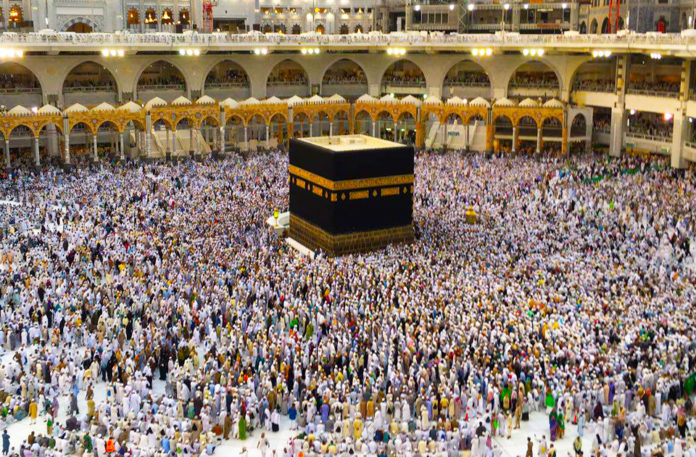The Prophet ﷺ said:
| An Umrah to an Umrah is an expiation for what is between the two. And a blessed Hajj does not have a reward for it except paradise. [Agreed Upon. Bulooghul Maraam (no. 693] |
Shaykh Safeeur Rahmaan Al Mubaarakfooree says:
| Hajj In the language, it is an endeavour |
Al Khaleel said:
| Most endeavours are to glorification. In Islaamic law: The endeavour to the Sacred House with specified actions. It is a pillar from the five pillars of Islam by agreement. It was first obligated in the sixth year according to the majority, and it has been said that it may have been in the seventh or tenth year. And Ibnul Qayyim has chosen that in Al Hudaa. [It’haaful Karaam (p. 198)] |
| The Blessings for making Umrah during Ramadan is equivalent to making Hajj with the Prophet ﷺ. [Reported by Al-Bukhari, Muslim, Ibn Maajah and others] |
The Umrah
If a pilgrim wishes to be ritually pure for Umrah, he should shed his clothing and bathe as he would after sexual defilement, if convenient. He should perfume his head and beard with the best oil he can find. There is no harm in what remains of it after Ihram.
Bathing for Ihram is sunnah for both men and women, including menstruating women and those experiencing postnatal bleeding. After bathing and preparing himself, a. pilgrim, other than those menstruating or experiencing postnatal bleeding, prays the obligatory prayer, if it is time. Otherwise, he makes his intention by praying the two sunnah rakahs which are made each time wudhu is performed.
When he finishes his prayer he should say:
| Here I am for Umrah, here I am, Oh Allah, here I am. Here I am. You have no partner. Here I am. Surely all praise, grace and dominion is yours, and you have no partner. [Talbeeyah]. |
A man raises his voice when saying this and a woman says it so that only one beside her may hear her.
One in Ihram should say the talbeeyah as often as possible, especially when times and places change. For example: when descending or ascending during travel or when day or night approach. He should also ask Allah for His pleasure, for Heaven and seek refuge in Allahs mercy from Hellfire.
One should say the talbeeyah during Umrah, starting from the time he puts on his Ihram till he starts tawaf. During Hajj he should say it starting from the time he puts on his Ihram till he starts to stone jamrah Al-Aqaba on the Eid day.
When a pilgrim enters the Holy Mosque he puts forth his right foot first and says:
| In the name of Allah, may peace and blessings be upon the Messenger of Allah. Oh Allah, forgive me my sins and open to me the doors of Your mercy. I seek refuge in Allah the Almighty and in His Eminent Face and in His Eternal Dominion from the accursed Satan. |
He approaches the black stone, touches it with his right hand and kisses it. If this isn’t possible, he should face the Black Stone and point to it.
It is best not to push and shove, causing harm and being harmed by other people.
When touching the Stone, a pilgrim should say the following:
| A pilgrim must walk, keeping the Kabah on his left. When he reaches the Rukn Al Yamani he should touch, but not kiss it, and say: |
| Our Lord, grant us good in this life and good in the hereafter and save us from the punishment of the Hell fire. Oh Allah, I beg of You for forgiveness and health in this life and in the Hereafter. |
Each time he passes the Black Stone he should say:
| Allah is the Greatest. |
During the remainder of his tawaf he may say what he pleases of supplications, mentioning Allah, and recitation of Quran. This is because tawaf, sayi, and stoning the jamrah have been devised for the purpose of mentioning Allah.
During this tawaf it is necessary for a man to do two things:
1. Al-ldhtebaa from the beginning of tawaf until the end. Al-ldhtebaa means placing the middle of ones reda under his right arm and the ends of it over his left shoulder.
When he is finished performing tawaf, he may return his reda to its original state because the time for Idhtebaa is only during tawaf.
2. Al-raml during the first three circuits. Al-raml means speeding up ones pace with small steps. A pilgrim should walk at a normal pace during his last four circuits.
When he completes seven circuits of tawaf, he approaches maqam Ibrahim and recites:
| And take ye the station of Abraham as a place of Prayer. Chapter 2, Verse 125 [2:125]. |
He prays two short Rakahs, as close as conveniently possible, behind maqam Ibrahim. During the first Rakah he recites surah al-kafirun [Chapter 109] and during the second one surah al-ikhlas [Chapter 112].
When he completes the two rakahs he should return to the black stone and touch it, if convenient. He goes out to the mesaa and when he nears as-safaa he recites:
| Verily As-Safaa and Al-Marwah are among the shrines of Allah. [2:158]. |
He ascends as-safaa until he is able to see the kabah. Facing the kabah and raising his hands, he praises Allah and makes any supplications he chooses. The prophet ﷺ prayed thus:
| There is no Deity but Allah alone, three times, supplicating in between. |
He descends as-safaa and heads for al-marwah at a normal pace until he reaches the green marker. He should then run fast until the next green marker. He continues toward al-marwah at a normal pace. When he reaches it, he ascends it, faces the qibla, raises his hands and repeats what he said on as-safaa. He descends al-marwah heading towards as-safaa, taking care to walk where walking is designated, and run where running is designated.
He continues this procedure until he completes seven laps. Going from as-safaa to al-marwah is a lap and returning is another lap.
During his sai he may recite what he wills of supplications, recitation of Quran, and mentioning Allah.
In completion of Sai he shaves his head. A woman clips her hair the length of a fingertip.
Shaving is preferable, except when Hajj is near and there isnt sufficient time for hair to grow back. In this case its best to clip so that hair will remain for shaving during Hajj.
With that, Umrah is completed and a pilgrim is free to dress in other clothing, wear perfume and engage in marital relations, etc.
(NOTE: If you want to build a strong and powerful relationship with Allah, check out Islamia TV, where you can watch Islamic speakers from across the globe deliver inspiring and motivational courses. Learn more at www.islamia.tv.)





















